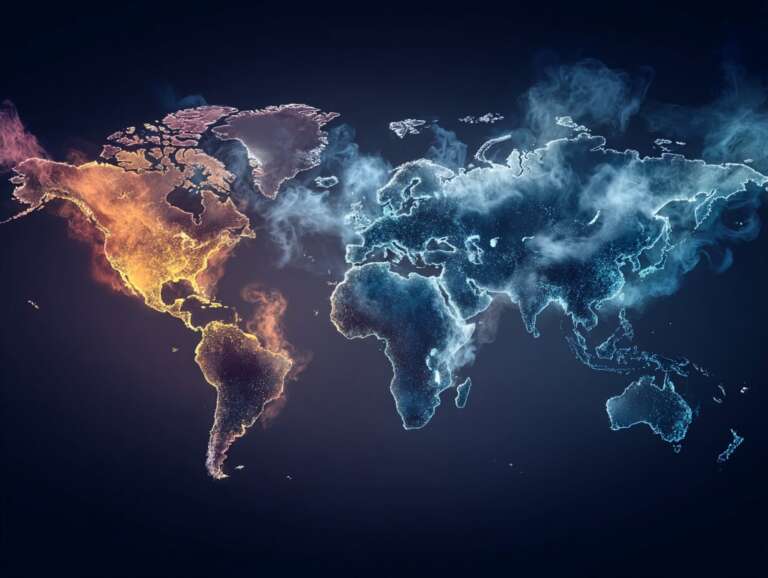Have you ever wondered why some weather patterns seem more extreme than ever before? The truth is, the atmosphere is changing, and it’s not just a passing trend. As CO2 levels soar to unprecedented heights, we’re witnessing a dramatic shift in our climate that’s reshaping the very fabric of our weather. From devastating hurricanes to scorching heatwaves, the connection between rising CO2 levels and extreme weather events is becoming alarmingly clear. Understanding this relationship is not just an academic exercise; it’s a call to action. This article will unravel the intricate ties between CO2 and extreme weather, equipping you with insights that can inspire personal and community efforts towards sustainability.
TL;DR: Increased CO2 levels are linked to more frequent and severe extreme weather events. Understanding this connection is crucial for effective climate action and adaptation strategies. Individuals can contribute to reducing CO2 emissions through lifestyle changes and advocacy.
What Exactly is CO2 and Where Does It Come From?
Let’s break it down: Carbon dioxide (CO2) is a greenhouse gas that traps heat in our atmosphere, playing a pivotal role in the greenhouse effect. But where does this CO2 come from? The major culprits are fossil fuels—think coal, oil, and natural gas—alongside deforestation and industrial activities. According to the National Oceanic and Atmospheric Administration (NOAA), atmospheric CO2 levels have surged from about 280 parts per million (ppm) before the Industrial Revolution to over 410 ppm today. This dramatic rise correlates directly with industrialization and our insatiable appetite for energy.
The numbers are staggering. The Intergovernmental Panel on Climate Change (IPCC) reports that human activities have increased CO2 concentrations by more than 40% since the late 18th century. This isn’t just a statistic; it’s a warning sign. As CO2 levels climb, so does the intensity and frequency of extreme weather events. It’s time to connect the dots between CO2 and the weather patterns we’re experiencing.
Extreme Weather Events: What Are They and Why Should You Care?
Extreme weather events are not just headlines; they are life-altering phenomena that can devastate communities. These include hurricanes, floods, droughts, and heatwaves—each with its own set of catastrophic consequences. For instance, Hurricane Harvey in 2017 dumped an astonishing 60 inches of rain on Houston, leading to widespread flooding and billions in damages. Similarly, the California wildfires have become an annual nightmare, fueled by rising temperatures and prolonged drought conditions.
What’s alarming is how these weather patterns have shifted in recent years. The frequency and severity of these events are on the rise, and they are directly linked to the increasing levels of CO2 in our atmosphere. The reality is shocking: the more CO2 we emit, the more extreme our weather becomes. This is not just a problem for scientists; it’s a crisis that affects you, your family, and your community.
The Science Behind CO2 and Weather Interactions
Here’s the brutal truth: CO2 doesn’t just sit idly in the atmosphere. It actively contributes to the greenhouse effect, trapping heat and causing global temperatures to rise. This increase in temperature leads to altered weather patterns—more evaporation means heavier rainfall, while higher temperatures can intensify droughts and heatwaves.
Research backs this up. A study published in Nature Climate Change found that extreme weather events are becoming more frequent due to human-induced climate change, primarily driven by rising CO2 levels. The implications are profound: as our planet warms, we can expect more severe storms, prolonged droughts, and unpredictable weather patterns. This isn’t just a future concern; it’s happening now, and it’s affecting lives.
Case Studies: CO2 Levels and Recent Extreme Weather Events
Let’s look at some real-world examples to understand the impact of elevated CO2 levels. Hurricane Harvey, which wreaked havoc in 2017, was linked to climate change. A study by the World Weather Attribution group concluded that climate change made the storm 15% more intense. Similarly, the California wildfires have been exacerbated by rising temperatures and prolonged drought, both of which are influenced by increased CO2 levels.
The economic and social costs of these disasters are staggering. According to the National Interagency Fire Center, the U.S. spent over $2 billion fighting wildfires in 2020 alone. These disasters don’t just affect the environment; they displace families, strain local economies, and create long-term health issues. The connection between CO2 and extreme weather isn’t just a scientific debate; it’s a pressing reality that demands our attention.
Mitigation Strategies to Combat CO2 Emissions
So, what can we do about it? The good news is that there are numerous strategies to combat rising CO2 levels. Globally, initiatives like the Paris Agreement aim to limit greenhouse gas emissions and promote renewable energy sources. Locally, communities are adopting conservation efforts and sustainable practices to reduce their carbon footprints.
But it doesn’t stop there. You can make a difference too! Simple lifestyle changes—like opting for public transportation, reducing energy consumption at home, and supporting local sustainability initiatives—can collectively lead to significant reductions in CO2 emissions. Advocacy for policy changes and community engagement in climate action are also crucial. Remember, every action counts, and together, we can combat climate change and its devastating effects on extreme weather.
Conclusion
The connection between rising CO2 levels and extreme weather events is undeniable and urgent. As we’ve explored, the implications of this relationship are profound, affecting not only our environment but also our communities and economies. Now is the time to reflect on our carbon footprints and consider practical steps to reduce CO2 emissions.
What actions will you take towards sustainability? Share your thoughts or actions in the comments below, and let’s inspire each other to make a difference. Together, we can tackle climate change and its impact on our weather patterns, ensuring a safer, more sustainable future for all.

